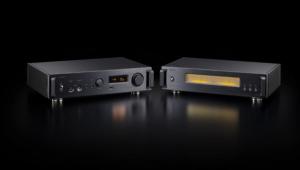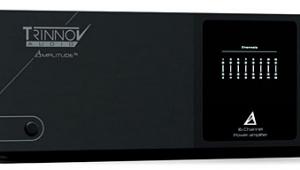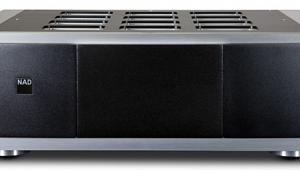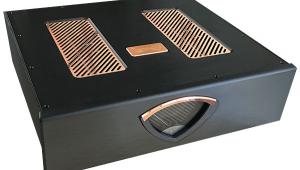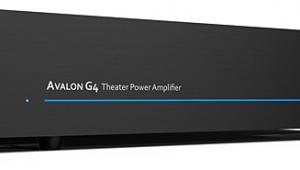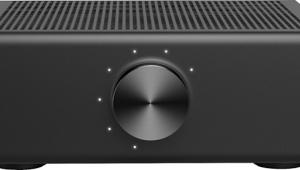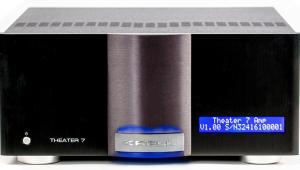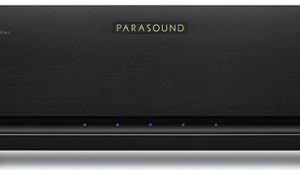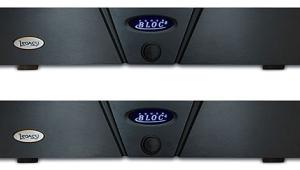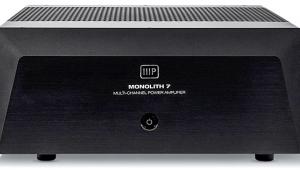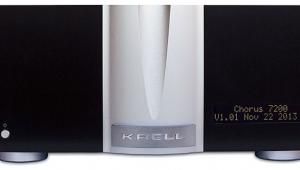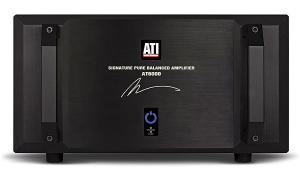Primare SP31.7 & A30.5 Mk.II surround preamplifier-processor & 5-channel amplifier

The Primare brochure states that, with their home theater components, "your beautiful living space and your beautiful home entertainment system will be perfectly harmonized." This may represent a bit of hyperbole (how do they know if I have a beautiful living space?), but I must admit that what first interested me in reviewing the SP31.7 and A30.5 Mk.II was their appearance. For a full-featured preamp-processor, the SP31.7 has just about the least cluttered front panel I've seen: two knobs, five small buttons, and a discreet display in the middle. The front panels of both the SP31.7 and the A30.5 have a brushed-metal finish that looks elegant in that understated Scandinavian way. As we shall see, that beauty is not just skin deep.
Design
The SP31.7 is the second preamp-processor from Primare, with a design team led by Michael Bladelius, who had already designed eight such products for other manufacturers— he's not exactly a novice at this sort of thing. For both the SP31.7 and the A30.5 Mk.II, the design principles are said to include the use of ultra-short signal paths, easy-to-use interfaces, and the best technologies appropriate for a given application.
The SP31.7 is actually a combination of three component designs. First and foremost, it's a balanced 2-channel or unbalanced multichannel analog preamplifier, with a design based on the Primare PRE30. Second, it's a multichannel digital surround-sound processor incorporating an alphabet soup of surround modes: DD, DD EX 6.1, DPL, DPLII, DTS, DTS ES 6.1 (Matrix and Discrete), DTS Neo:6, Matrix 6.1 (a proprietary mode that derives a rear-center channel from the right and left surround channels of a Dolby Digital 5.1 datastream), and Surround EX 7.1 (another proprietary mode that derives two rear channels from a DD 5.1 datastream). Finally, it's a video switcher with bandwidth extending to 500MHz (component video), which meets professional HDTV standards.
Audio inputs are fully configurable, so you can decide which of eight sets of analog inputs you want to use for each of your analog sources, and which of eight digital inputs (including one AES/EBU) are to be used with your digital sources. Up to four pairs of analog inputs can be configured for a multichannel source—e.g., a multichannel SACD, DVD-Audio, or universal player—keeping the signals in the analog domain. For each source, you can define the type of audio input (analog or digital), video input (composite, S-video, or component), default surround mode, and, for analog sources, offset to balance the loudness when switching sources. The SP31.7 provides conversion between S-video and composite outputs, not component video, and onscreen display is provided only through the composite and S-video outputs.
Primare touts an "ultra-flexible bass management system" for the SP31.7, and I agree with this description—other than for multichannel SACD/DVD-A sources, which use an analog bypass mode, so no digital signal manipulation is possible. (With the Sonic Frontiers Anthem AVM 20 pre-pro, which I reviewed in the May 2002 SGHT, you have a choice between bypass, which doesn't allow multichannel bass management, and A/D conversion of each channel, which does, albeit at a slight sonic penalty.) For digital and 2-channel analog (non-bypass) sources, you can set each speaker or set of speakers as Small or Large. The crossover is variable from 40 to 200Hz (I used 60Hz), and there are bass modes that send the low bass (LFE and/or bass in the front channels) to the sub and/or Large speakers in various combinations.
A feature considered de rigueur in this price range, which is present in the SP31.7, is processor and control software that can be upgraded via RS-232. Presumably, this means that when Dolby Labs and DTS join forces (ha!) to come out with DDTS ES EX Neo 6.1xp, the SP31.7's Cirrus Logic CS493263 chip and associated digital circuitry can be configured to accommodate it. The SP31.7's digital signal path permits up to 24-bit/192kHz processing.

Unlike some of its competitors (e.g., the Anthem AVM 20), the SP31.7 does not have variable time delay to correct the lip-sync problems (video coming after the sound) that some video processing is prone to. In fairness, however, while I've observed some lip-sync problems with digital satellite programs, they have been intermittent in nature. And even if a preamp-processor has the audio delay option, this type of problem is a nuisance to correct: by the time you've dialed in the appropriate time delay, the problem may be gone. And you then have to remember to restore the default so that you're not using time delay with a program that doesn't need it. But if a fixed delay is produced by your video processing (which happens with some televisions and projection setups) and not by the source, the lip-sync adjustment can be set and left unchanged for all program material—apart from a source that has its own problems!
The SP31.7's companion, the A30.5 Mk.II 5-channel power amplifier, also follows the design principle of ultra-short signal paths, including the AC wiring: the power switch is on the rear panel, where the power comes in, rather than in the more convenient but technically less desirable front-panel location. Primare places great emphasis on the power supply, and on making sure there is no interaction between channels. Rather than using a single large transformer, as is typical in multichannel amplifiers, the A30.5 has a separate toroidal transformer for each channel; this could be described as "quintuple-mono construction." There is also an emphasis on current capability, with a total of 40 amps on tap. Although the SP31.7 has a pair of XLR inputs and outputs, the A30.5 Mk.II's inputs and outputs are all RCA.
Setup
The SP31.7 and A30.5 Mk.II arrived while I was in the midst of revamping my home-theater reference system (see sidebar, "A New Reference System"), a process that involved a certain amount of weeping, wailing, and gnashing of teeth. So when Sumiko's East Coast representative, Patrick Butler, called to say that he was going to be visiting dealers in my area and suggested he come by to help set up the Primares, I took him up on his offer.

The standard approach to setting channel levels in a home theater system involves using an SPL meter (I use the analog model from RadioShack) at the listening area to match the levels of the calibration white noise generated by the pre-pro. The SP31.7's manual makes reference to an automatic calibration system that uses a microphone plugged into the unit, but notes that "this option is not available in all markets"—and North America is one of the markets in which it's not available. I'm not surprised by this: the folks at Sumiko are not fans of a measurement-based approach to system setup, preferring to use their ears.
Patrick Butler brought along DVDs that he is very familiar with and that he routinely uses to help dealers set up surround-sound systems. He took a good couple of hours, listening intently, then making changes in levels and/or delay settings, listening again, then tweaking the settings again, and so on. I suspect that few consumers would take the time—or have the analytical listening skills—to set up a home theater system in this manner, but when he was finished, the sound jelled in a most convincing way. Just to satisfy my curiosity, after Butler left I checked the levels with the calibration noise and the SPL meter, and found that his settings differed from the by-the-numbers settings by only a few dB.
For the novice home-theater user, setting up a pre-pro can be a daunting task, and setting speaker levels and delays is only part of it. With a product as sophisticated as the SP31.7 at the heart of a system, there are a lot of cables to connect and a lot of decisions to make about what the SP31.7 should do with all those signals. If the SP31.7 is at least the second such product you've had in your system, its setup should not prove difficult, but its manual is not among the most explicit and logically laid out, so you might be better off having the dealer do this chore.
 The SP31.7 does permit a considerable amount of individualization, including the ability to define two "aliases" for the same input; for example, you can have the output of a DVD player defined as Music, with 2-channel as the reproduction mode, and as Movies, with PLII Cinema as the mode for movie soundtracks. The setup software also lets you designate each source as Enabled or Disabled. This is handy—selecting a source from the front panel or the remote involves scrolling through all the alternatives until you get to the one you want, and Disabled sources are not included in this sequence. My preference would be for one-button direct access, but the Disabled/Enabled feature is a reasonable alternative.
The SP31.7 does permit a considerable amount of individualization, including the ability to define two "aliases" for the same input; for example, you can have the output of a DVD player defined as Music, with 2-channel as the reproduction mode, and as Movies, with PLII Cinema as the mode for movie soundtracks. The setup software also lets you designate each source as Enabled or Disabled. This is handy—selecting a source from the front panel or the remote involves scrolling through all the alternatives until you get to the one you want, and Disabled sources are not included in this sequence. My preference would be for one-button direct access, but the Disabled/Enabled feature is a reasonable alternative.
As for the remote control—well, don't get me started. The SP31.7 comes with the C31 remote, which can control and is available as an upgrade for other components in the Primare line. It's made of beautifully finished metal, has shiny stainless-steel buttons, and is quite stylish in appearance. It's also less convenient to use than any remote control in my experience. It didn't help that the first two samples of the C31 didn't work properly: buttons had to be pressed twice to get them to respond. This turned out to be a manufacturing defect in a batch of control microprocessors; the third sample I received was free of this problem.
- Log in or register to post comments
